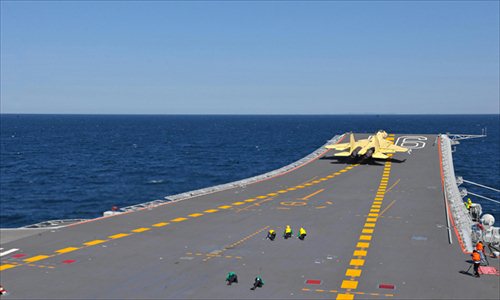Aircraft carrier sets sail for South China Sea

China's first aircraft carrier, the Liaoning, returned to its homeport on Sept. 21 after a three-month voyage, during which it carried out major and crucial tests.Photo: chinanews.com
Related report: A milestone for China’s 1st aircraft carrier
China's first aircraft carrier Liaoning set sail Tuesday en route for sea trials in the South China Sea for training purposes, in a critical step to strengthen its combat capability.
The aircraft carrier left its home port in Qingdao, East China's Shandong Province, the Xinhua News Agency reported. It was escorted by two missile destroyers, the Shenyang and Shijiazhuang, as well as two missile frigates, the Yantai and Weifang.
The trials in the South China Sea, over which China and several neighboring countries have territorial disputes, have raised speculation over the intention of the move, while the People's Liberation Army (PLA) Navy said it was a "normal arrangement."
This is the first time the Liaoning aircraft carrier has embarked on a cross-sea training voyage since it was commissioned into the PLA Navy last year, Liaoning's captain Zhang Zheng told Xinhua.
Long cross-sea voyages are a necessary stage of experimentation and training to test equipment and crews under continuous work and different hydrological and meteorological conditions, he said.
Since its commission into the PLA Navy on September 25, 2012, the Liaoning and its crew have "conducted a series of tests and training drills, including landings and takeoffs by various aircraft, including the J-15 carrier-borne fighter," Xinhua reported.
Authorities did not specify what drills the Liaoning will carry out for its first-ever trials in the South China Sea.
En Shuo, a military expert, said that the oceanographic conditions of the South China Sea are suitable for the training courses the Liaoning must undertake, and the trials are expected to raise the fleet's capability as a battle group.
Zheng Ming, a retired PLA Navy rear admiral, shares a similar view, saying the voyage marks the second phase of a three-step development to strengthen the Chinese aircraft carrier's combat capability.
With the inclusion of four other ships, the PLA Navy is moving on to aircraft carrier formation as opposed to close coordination between ship-borne aircraft and the aircraft carrier, Zheng said.
"This type of coordination not only requires technological cooperation - making sure the ships have the same speed - but also requires tactical cooperation so as to make different lineups to deal with air and maritime threats. It requires a higher level of command, control and management," he said.
The Liaoning's sea trials, coming just days after China established an Air Defense Identification Zone above the East China Sea, have attracted great attention from neighboring countries, many of whom have territorial disputes with China over sea boundaries.
Japanese broadcaster NHK speculated the fleet may sail between the main island of Okinawa and Miyako Islands.
Reuters quoted Joseph Cheng, a political science professor at the City University of Hong Kong as saying, "Obviously, the Chinese authorities have been adopting a series of measures to strengthen their claim on the sovereignty of the disputed territories."
However, Xinhua quoted the PLA Navy as saying that the sea trial is a normal step in the carrier's schedule of training.
Dismissing the nation that the trials can be seen as a gesture of offense, Zheng said cross-sea training voyages are a method for the PLA Navy to adapt to different waters.
"The South China Sea has different wave and water conditions than other seas, it has a higher salt density, the crews and equipment all need to adapt to the conditions," he said.